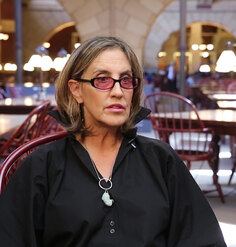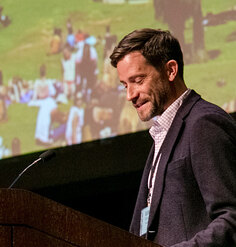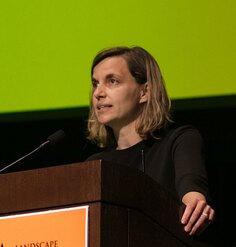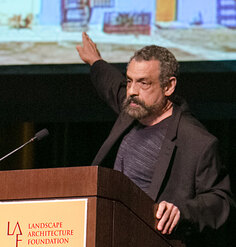Beyond Practice
By Martha Schwartz
This presentation was part of the Landscape Architecture Foundation’s The New Landscape Declaration: A Summit on Landscape Architecture and the Future held in Philadelphia on June 10-11, 2016. LAF asked a diverse group of leading minds to write a “Declaration” reflecting on the last half century and offering bold ideas for how landscape architecture can make its vital contribution in response to the challenges of our time.
Martha Schwartz
Principal, Martha Schwartz Partners
New York, New York
Martha Schwartz is principal of Martha Schwartz Partners and has over 35 years of experience as a landscape architect, urbanist, and artist. Schwartz is professor in practice of landscape architecture at Harvard Graduate School of Design, a founding member of the Working Group of Sustainable Cities at Harvard University, and was appointed in 2015 as a Built Environment Expert (BEE) of the Design Council Cabe.
* Affiliation at the time of the Summit
Beyond Practice: Landscape Architects and the Global Eco-Crisis
by Martha Schwartz
The scientific consensus is that anthropogenic climate change is now indisputable. James Hansen, the leading climate scientist previously from the National Aeronautics and Space Administration (NASA) and respected for many predictions that have proven to be true, recently issued a grim warning that we are nearing the point of no return when it comes to reversing or even mitigating the adverse effects of climate change.
Several alarming facts provide evidence that global warming is upon us and happening faster than predicted: (1) 2015 was the warmest year on record, and this past decade is the warmest since 1880; (2) in November of 2015, a one-degree-Celsius planetary rise in temperature was officially acknowledged (but widely believed to be conservative)—the halfway mark to the two-degrees-Celsius target or safe limit to avoid catastrophic global warming; and (3) East Siberian Arctic Shelf (ESAS) methane is being released—the most threatening fact of all.
We have exceeded the projected tipping point of 350 parts per million of carbon dioxide (CO2) and are now at 400 parts per million, heating up our land, air, ice, and oceans with the equivalent of 400,000 Hiroshima atomic bombs per day. Global ocean temperatures are now one degree Celsius higher than they were 140 years ago. The heated Arctic Ocean is causing the permafrost of the ESAS to melt, releasing methane—a gas 20 to 30 times more potent than CO2 as a heat-trapping gas—into the atmosphere. There are such massive reserves of methane in the subsea Arctic that if only a small percentage is released, it can lead to a jump in the average temperature of the Earth’s atmosphere by ten degrees Celsius.
Recent observations in the Siberian Arctic show that increased rates of methane are escaping from the seabed now. These facts have produced a plausible scientific prediction of a catastrophic release, or bubble, of methane occurring abruptly or in coming decades. Such a release could have an exponentially amplifying effect on global warming, launching catastrophic scenarios more rapidly than we had anticipated.
The 1966 Declaration of Concern correctly predicted and responded to the environmental crisis with a vision 50 years ago. The ecological planning initiatives and educational goals that were projected have been accomplished. At this point, however, we confront a drastic new challenge. In 1966, those visionaries could not foresee globalization or the population explosion with corresponding fossil fuel use and consumption that have outstripped all our profession’s good intentions and achievements regarding sustainable development through responsible design.
I no longer believe that the work we do as individual, responsible practitioners will be able to contribute effectively to averting this long-predicted crisis because we are entering a state of emergency. We do not have another 50 years or perhaps even 15. Sadly, our excellent professional practices will become irrelevant in the face of global warming, a problem whose magnitude we are now confronting. I do not advocate putting an end to our professional excellence or our individual duties as responsible practitioners. But my message is: we must go beyond landscape architecture practice in order to broach this critical environmental crossroads.
The questions before us are: What can be done to keep this scenario from playing out? What can we do as a group of people whose ethos is to steward our natural environment, since the impacts are coming much sooner than expected?
My declaration is for a collective call to action. We must advocate for funding the development and testing of a portfolio of geotechnologies to counteract man-made global warming until the required reductions in CO2 emissions are reached and we have transitioned to sustainable energy economies.
As a first priority, we should develop techniques to cool the Arctic because the possibility of a major methane release triggered by melting Arctic ice constitutes a planetary emergency. Technologies have been proposed for rapidly cooling the Arctic on the necessary scale in the form of solar radiation management (SRM). We should be investing in research and development toward this goal immediately.
At the same time, we must focus on measures that can reduce existing quantities of atmospheric CO2 by carbon dioxide removal (CDR) processes to lower the pollutant level and warming effects.
Finally, cutting global greenhouse gas emissions must remain an urgent priority; thus, reducing emissions from existing, new, and proposed carbon power stations, particularly coal plants, with carbon capture and storage (CCS) techniques, must be rigorously pursued.
Scientists have conceived various methods—and new ones may be discovered—to achieve these goals, so it is very likely to be technically feasible. But much more research and testing is needed before deployment. I believe that science can help us out of this imminent and dire situation in order to buy time so that the longer-term goal of zero carbon emissions can eventually be achieved.
Therefore, I urge our professional organizations to create a political wing with a forceful agenda to persuade our decision makers and politicians to support bold research to save our planet’s atmosphere through technologies that can prevent Arctic methane release, and sequester and capture carbon dioxide. We must exert pressure on our government to fund the equivalent of a “Manhattan Project for Climate Change Mitigation” in response to the clear and present environmental danger we are now facing, especially with regard to Arctic methane release. Such a political agenda should also have a focused social media voice. It is through these modalities that change can occur. Petitions and signatures impel those in power to exert the voice of the people. This is today’s version of taking to the streets. We must become online warriors.
We are a well-educated, knowledgeable group that has the status to influence people. Together, we have the power to create awareness about this environmental emergency and to make change. I further propose that we, as a group of dedicated landscape architects, immediately embark upon a hyperaggressive climate campaign that should be owned by the two most important professional organizations that represent us: the American Society of Landscape Architects (ASLA) and the Landscape Architecture Foundation (LAF). We must urge these two organizations to officially recognize the gravity of the situation and align with and support other actionable networks, such as 350.org, Friends of the Earth, Greenpeace, the Arctic News, and the Arctic Methane Emergency Group, among others, that are working heroically and aggressively on climate change policy and action.
Finally, ASLA has a lobbying arm in Washington, DC. We must exercise our full intellectual authority and political influence to strategically advance climate rescue.
In summary, I am suggesting that we shift our priorities from individual practice to group political action so as to impel our government to forge an international effort to cool the Arctic, suppress methane, and aggressively remove CO2 from the atmosphere; take immediate and extremely drastic action to entirely curb global carbon dioxide emissions; and evolve rapidly toward completely renewable energy resources.
I have hope that the world’s best scientists will find ways to buy us the gift of time so that we can avert the swift intensification of climate change. Then we will be given a second chance to learn how to live in balance with the earth. But we must act together now.
The author would like to thank Edith Katz, formerly of Martha Schwartz Partners, for her invaluable assistance.











